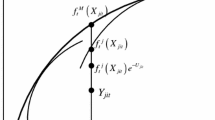A stochastic frontier model is considered – a linear regression model linking the firm activity measure (e.g., the production volume of an enterprise) and the resource inputs. This model is used to determine the efficiency of decision-making units (DMUs). A series of stochastic experiments is run to determine the model’s ability to rank the DMUs by efficiency – a Spearman rank correlation coefficient and the Harrell concordance index are calculated as a function of the variance of the two error components of the regression model: a normally distributed stochastic shock and an inefficiency index with half-normal or exponential distribution.
Similar content being viewed by others
References
Australian Competition and Consumer Commission, Benchmarking Opex and Capex in Energy Networks, ACCC/AER Working Paper Series, No. 6 (May 2012).
A. Schweinsberg, M. Stronzik, and M. Wissner, Cost Benchmarking in Energy Regulation in European Countries, WIK-Consult (Final Report) (2011).
E. I. Shchetinin and E. Yu. Nazrullaeva, “The production process in food industry: interrelationship of fixed-asset investment and technical efficiency,” Prikladnaya Ekonometrika, 28, No. 4, 63–84 (2021).
I. B. Ipatova, “Dynamics of total factor productivity and its components: the case of Russia’s plastics industry,” Prikladnaya Ekonometrika, 38, No. 2, 21–40 (2015).
E. Bessonova and A. Tsvetkova, “Productivity convergence trends within Russian industries: Firm-level evidence,” Bank of Russia Working Paper Series wps 51, Bank of Russia (2019).
V. Makarov, S. Aivazyan, M. Afanas’ev, A. Bakhtizin, and A. Nanavyan, “Modeling regional economic growth and efficiency of the innovation space,” Forsait, 10, No. 3, 76–90 (2016).
S. A. Aivazyan, M. Yu, Afanas’ev, and A. V. Kudrov, “Productive potential models and estimates of regional technological efficiency in Russia allowing for production structure,” Ekonomika i Matematicheskie Metody, 52, No. 1, 28–44 (2016).
S. A. Aivazyan, M. Yu, Afanas’ev, and V. A. Rudenko, “Investigating the dependence of random components of the stochastic production function in technical efficiency estimation,” Prikladnaya Ekonometrika, 34, No. 2, 3–18 (2014).
V. A. Rudenko, S. A. Aivazyan, and M. Y. Afanasyev, “Specification of a stochastic production function model in the extended class of stochastic frontier models,” Modeling of Artificial Intelligence, 4, No. 1, 21–28 (2017).
V. A. Rudenko, “Specification scheme of the stochastic production function for assessment of technical efficiency of the regions in the Russian Federation,” Russian Journal of Mathematical Research, Series A, 4, 38–47 (2018).
M. Farrell, “The measurement of productive efficiency,” J. Royal Statistical Society, Series A, General, 120, 253–281 (1957).
D. Aigner, C. A. K. Lovell, and P. Schmidt, “Formulation and estimation of stochastic frontier function models,” J. Econometrics, 6, 21–37 (1977).
D. I. Malakhov and N. P. Pil’nik, “Efficiency estimation methods in stochastic production-frontier models,” Ekonomicheskii Zhural Vysshei Shkoly Ekonomiki, 17, No. 4, 660–686 (2013).
S. C. Kumbhakar and C. A. K. Lovell, Stochastic Frontier Analysis, Cambridge University Press (2003).
C. Winsten, “Discussion on Mr. Farrell’s Paper,” J. Royal Statistical Society, Series A, General, 120, 282–284 (1957).
W. C. Horrace, R.-S. Seth, and I. Wright, “Expected efficiency ranks from parametric stochastic frontier models,” Empirical Economics, 48, No. 2, 829–848 (2015).
D. Feng, C. Wang, and X. Zhang, “Estimation of inefficiency in stochastic frontier models: a Bayesian kernel approach,” J. Productivity Analysis, 51, No. 1, 1–19 (2019).
F. E. Harrell Jr., R. M. Califf, D. B. Pryor, K. L. Lee, and R. A. Rosati, “Evaluating the yield of medical tests,” J. American Medical Association, 247, No. 18, 2543–2546 (1982).
R. B. Newson, “Comparing the predictive powers of survival models using Harrell’s C or Somers’ D,” The Stata Journal, 10, No. 3, 339–358 (2010).
E. V. Rumyantseva and K. K. Furmanov, “Using out-of-sample Cox–Snell residuals in time-to-event forecasting,” Business Informatics, 15, No. 1,: 7–18 (2021).
W. H. Greene, Econometric Analysis, 8th edition, Pearson (2018).
Author information
Authors and Affiliations
Corresponding author
Additional information
Translated from Prikladnaya Matematika i Informatika, No. 71, 2022, pp. 81–94.
Rights and permissions
Springer Nature or its licensor (e.g. a society or other partner) holds exclusive rights to this article under a publishing agreement with the author(s) or other rightsholder(s); author self-archiving of the accepted manuscript version of this article is solely governed by the terms of such publishing agreement and applicable law.
About this article
Cite this article
Nikol’skii, I.M., Furmanov, K.K. Ranking Accuracy of the Efficiency Index in the Stochastic Frontier Model. Comput Math Model 33, 319–329 (2022). https://doi.org/10.1007/s10598-023-09575-4
Published:
Issue Date:
DOI: https://doi.org/10.1007/s10598-023-09575-4




